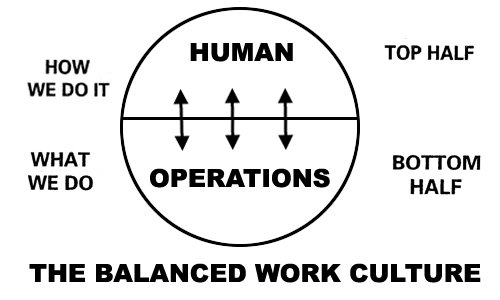Company cultures have two halves, the Human and the Operations. The key to building a more engaged and productive workplace is balancing these — balancing what we do with how we do it.
The human, or top-half of culture, includes feelings, communications, and values. The operational half includes everything that is not distinctively human, such as equipment and processes. See also The Five Levels of Culture.
The human half carries the why and how of culture. For example, we do things because they meet our desires, and we do things through communications and relationships. The bottom half, or operational half, contains what we do. For example, we build a bridge, we manufacture products, we sell goods at a retail outlet, we move production offshore.
Balancing the Two Halves — What and How
What we might change is a production line. How we do it might involve — or not involve — the people affected by the change.
People’s attitudes are more affected by how things are done than by what is done. Most of what people do in organizations comes from outside their control; from customers, markets, technology changes, regulations, upper management’s directives, and laws. In contrast, managers can mostly control how they do things.
People usually don’t mind changes if they are involved in them. On the other hand, if the changes are made by upper managers, and then announced to employees, they may feel ignored, and be unhappy. Balancing the culture means paying attention to how you do what you do.
cc 122 — © Barry Phegan, Ph.D.

